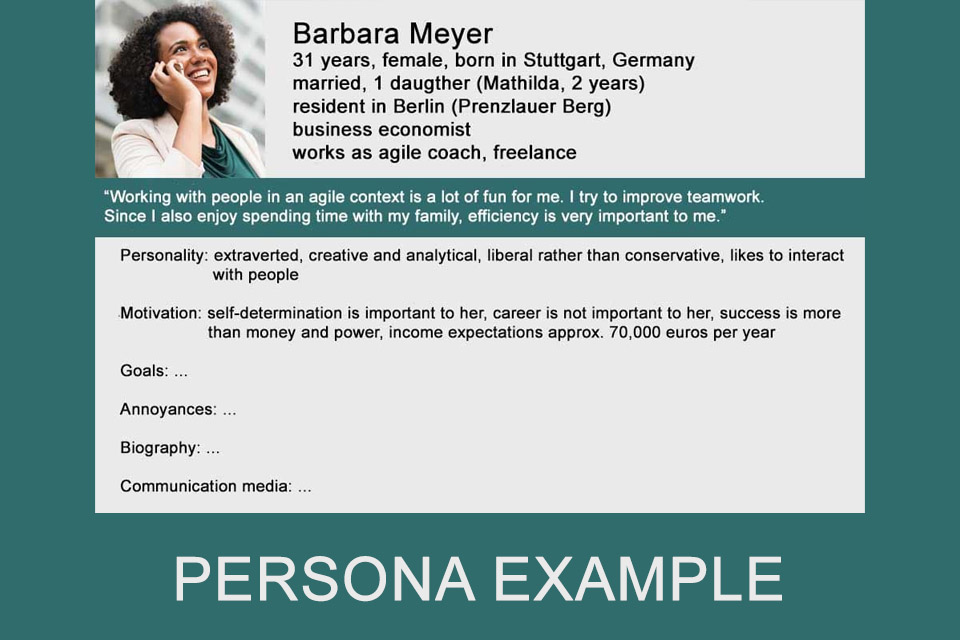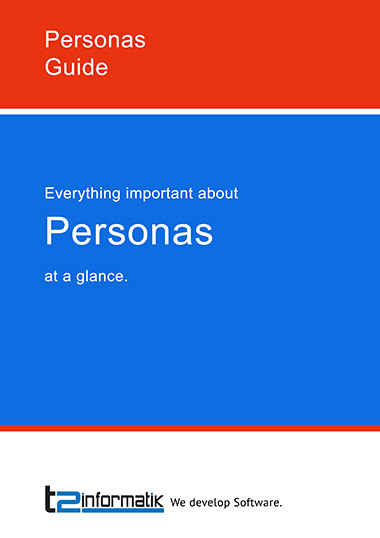What are Personas?
Smartpedia: Personas personify target groups and help to make assumptions about customers. As fictitious users, they help to better understand the needs, attitudes and actions of potential users.
Personas Definition
Personas illustrate typical representatives of a target group. A persona has expectations, values, desires and goals and shows human behaviour. It is the personification or prototype of a target group and helps to make assumptions about customers.
As fictitious users, personas are described with concrete characteristics such as name, photo, place of residence, curriculum vitae, marital status, age, income, education, skills, attitudes, hobbies, etc. However, they do not represent the average of a target audience, but appear as persons who show patterns in usage behaviour. For this reason, companies often develop several representatives of a target audience.
The Development of Personas
It is often difficult for companies to predict the market and demand. It is also often difficult to observe customers using products and to find out their impressions and wishes. This is where the persona concept formulated by Alan Cooper in his book “The Inmates are Running the Asylum” in 1999 can help.
Already in 1983 Alan Cooper conducted interviews with potential users in the course of his software development. This allowed him to get to know their needs and develop solutions for them. If companies conduct interviews today, this requires a lot of preparation and professionalism. Interview partners are easily influenced unconsciously by the type of question, the reaction to answers or the formulation of questions. In the worst case, additional confirmation biases occur, which lead to the gathering of evidence in order to confirm one’s own expectations. What can companies do to avoid falling for their own assumptions? Or put differently: According to which criteria should companies develop personas?
The answer is: costs. Professional interviews cost money and time. Both are usually only available to a limited extent. But what is more expensive for an organisation: an investment to conduct interviews with clear insights and ideas about the potential users or the weeks or even months of development of products and solutions in an uncertain direction? It is important for companies to understand what their customers and users need. Interviews are a good way to get this information. By the way, Alan Cooper recommends conducting ten to twelve interviews.
Characteristics of Personas
There are different opinions about what characteristics personas should be described with. Here is a selection:
- “Realistic” first and last names
- Demographic characteristics such as age, gender, place of residence/region, education, occupation, position, marital status, income, etc.
- Photo
- Hobbies, interests and skills
- Feelings, attitudes and expectations, but also challenges and frustrations
- Interactions with other people, products and services, including with other personas where appropriate
Of course, many other criteria can be defined, such as the name of the cat, the favourite number or the favourite footballer. Even if this is probably fun, the purpose of the work is to better understand potential users and customers. Companies should therefore always ask themselves to what extent information is relevant for the development of their products and services.
Demarcation of Personas and Target Audience
The term target audience refers to a group of people for whom a product or service is being developed or which is to be addressed in the form of defined communication. A target group is a part of the overall market that can be quantitatively determined by means of socio-demographic characteristics, psychological characteristics or actions. But this determination is still relatively imprecise. Only because two married persons were born in the same place, in the same year and live in the same street, they do not have to behave the same. This is where the persona concept comes in. A persona is a fictitious person who gives a typical customer a profile and a concrete face. He or she is thus part of a target group that helps to qualitatively understand the needs, challenges or actions of the potential user.
Types of Personas
Personas are used in many areas. They are used in sales, marketing and advertising, in requirements engineering, in project management and product and system development, in service and support as well as in corporate development. In the Design Thinking approach they are also firmly linked. It is easy to deduce from this multitude of application areas how useful and adaptable the concept is for many companies and divisions.
According to Alan Cooper, there are three different types of personas:
- the marketing persona,
- the proto persona,
- and the design persona.
In the meantime, often also
- buyer persona (as a description of the various roles in the buying process such as buyer, influencer and decider),
- candidate persona (as a tool for an optimised approach to applicants),
- customer persona (to differentiate between existing customers),
- user persona (as a regular user of a solution or product) or search persona
are used. This also shows how adaptable the persona concept is.
Persona Concept by Project Phases
Personas can be used in different project phases such as the
- project preparation for analysis,
- project implementation and
- in the operation of solutions.
For example, the earlier there is a concrete idea of potential users and their capabilities, the better products can be defined that will help these users later. The focus is on user goals as well as difficulties and challenges.
In the course of a project, their habits and preferences can serve as orientation to keep track of the goals and developments of the project. In this way, companies avoid a self-referential design or scope creep.
When operating solutions, they help to optimise. Does the ordering process work so easily and quickly that persona Barbara Meyer finds her way around easily or does she stop at the latest when checking out? Does the navigation and documentation meet Barbara’s requirements? The answers to such questions often reveal potential for improvement.
Advantages of Personas
Working with the persona concept offers the following advantages:
- It is a very good means of communication because it facilitates the analysis at the beginning of the project, the discussion about solutions during the project implementation and the optimisation of products and services in the company.
- It is versatile because it can be used universally in many areas and situations.
- Personas are present. With an appropriate visualisation, the project participants always have the target persons in view and thus the entire product and solution development becomes more lively.
- It promotes the understanding of different customers and users, because one thing quickly becomes clear: “the” user does not exist. For example, it is not enough to always implement features from the same perspective for one user.
- Working is fun and promotes empathy with potential users and customers.
Tips on Personas
Here you will find some tips for working with personas:
- Develop as many personas as you need. What is useful is what helps you in your area and your situation.
- Define each persona more realistically and typically than idealised.
- Discover the passion of each persona. For example, you can ask the following questions:
What content would he or she share on the Internet?
Which services would he or she subscribe to and which influencers would he or she follow?
What attracts his/her attention and what does she look for? - Visualise the results, e.g. with printouts that you hang on walls.
- Develop your target persons further over time. Barbara Meyer may be using a new mobile phone and can now be reached more frequently online. You can use such insights in product development as well as in communication.
The Development and Continuous Use
If companies want to use the persona concept, there are two ways for them:
- the use of proto personas and
- the implementation of market research and workshops.
A proto or ad hoc persona is created on the basis of existing knowledge about the target group. It contains few details and only focuses on the needs of the fictitious user. At the beginning of product development, they promote a uniform understanding within the team and help to prioritise development goals.
However, proto personas cannot replace data-based personifications. For the development of data-based target persons, market research is recommended, i.e. conducting interviews, observing users, using stakeholder information, feedback from focus groups, evaluating surveys or studying reviews and previous studies, etc. The development of data-based target persons can also be supported by market research. Workshops can be used to process the results. Although market research and workshops are relatively complex, the alternative would be to develop products permanently without a basis for strategic decisions. A workshop consists of three steps:
- collection, evaluation and specification of data
- development and specification of persona scaffolds
- detailing and documentation of each persona found
It is advisable not only to document the results on the intranet, but also to visualise them with posters in the team rooms. This way the team members have the fictitious users in mind every day, the understanding for them is automatically promoted and the potential users move into the centre of product development.
Do you think it ca be useful for organisations to define “negative personas”, for example to increase efficiency in customer acquisition?
Notes:
If you like the article or would like to discuss it, please feel free to share it in your network. And if you have any comments, please do not hesitate to send us a message.
Here you can find a short video on personas.
Here you can download a persona template for free.
And here you can find additional information from the t2informatik Blog:




